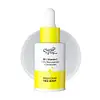What's inside
What's inside
 Key Ingredients
Key Ingredients

 Benefits
Benefits

 Concerns
Concerns

No concerns
 Ingredients Side-by-side
Ingredients Side-by-side

Water
Skin Conditioning3-O-Ethyl Ascorbic Acid
Skin ConditioningDimethyl Isosorbide
SolventButylene Glycol
HumectantEthoxydiglycol
HumectantSodium Citrate
BufferingCitric Acid
Buffering1,2-Hexanediol
Skin ConditioningSodium Gluconate
Skin ConditioningFerulic Acid
AntimicrobialCoceth-7
EmulsifyingPhenoxyethanol
PreservativePPG-1-PEG-9 Lauryl Glycol Ether
EmulsifyingFullerenes
AntimicrobialTocopheryl Acetate
AntioxidantEthylhexylglycerin
Skin ConditioningPEG-40 Hydrogenated Castor Oil
EmulsifyingPvp
Emulsion StabilisingTrisodium Ethylenediamine Disuccinate
Water, 3-O-Ethyl Ascorbic Acid, Dimethyl Isosorbide, Butylene Glycol, Ethoxydiglycol, Sodium Citrate, Citric Acid, 1,2-Hexanediol, Sodium Gluconate, Ferulic Acid, Coceth-7, Phenoxyethanol, PPG-1-PEG-9 Lauryl Glycol Ether, Fullerenes, Tocopheryl Acetate, Ethylhexylglycerin, PEG-40 Hydrogenated Castor Oil, Pvp, Trisodium Ethylenediamine Disuccinate
 Reviews
Reviews

Ingredients Explained
These ingredients are found in both products.
Ingredients higher up in an ingredient list are typically present in a larger amount.
You might know this ingredient as Ethyl Ascorbic Acid, a more stable version of ascorbic acid.
Like other types of vitamin C, this ingredient has many benefits including reducing wrinkles, skin soothing, dark spot fading, and fighting against free radicals.
3-O-Ethyl Ascorbic Acid interferes with the process of skin darkening, helping to reduce hyperpigmentation. It also encourages the skin to produce more collagen.
Once applied, 3-O-Ethyl Ascorbic Acid is converted to Vitamin C deeper in the skin's layers. This process is slow but makes this ingredient more tolerable for skin.
The optimum pH range for this ingredient is 4 - 5.5
Learn more about 3-O-Ethyl Ascorbic AcidDimethyl Isosorbide is a low-irritation solvent that helps deliver actives into your skin. It is created from glucose.
Research shows how well this ingredient works depends on the active and formulation rather than the concentration alone. This means adding more Dimethyl Isosorbide does not guarantee better penetration of ingredients into the skin.
Ethoxydiglycol is a synthetic solvent.
Solvents are used to keep ingredients together in a product. They can help dissolve ingredients to stable bases or help evenly distribute ingredients throughout the product.
Ethoxydiglycol also helps deliver other key ingredients into the skin.
Learn more about EthoxydiglycolPhenoxyethanol is a preservative that has germicide, antimicrobial, and aromatic properties. Studies show that phenoxyethanol can prevent microbial growth. By itself, it has a scent that is similar to that of a rose.
It's often used in formulations along with Caprylyl Glycol to preserve the shelf life of products.
This is the synthetic salt of gluconic acid, a form of PHA and mild exfoliant.
It is mainly used to stabilize oil and butter formulations from going bad. Sodium gluconate is a humectant, pH regulator, and chelating agent.
Chelating agents help neutralize unwanted metals from affecting the formulation.
Sodium gluconate is water-soluble.
Learn more about Sodium GluconateWater. It's the most common cosmetic ingredient of all. You'll usually see it at the top of ingredient lists, meaning that it makes up the largest part of the product.
So why is it so popular? Water most often acts as a solvent - this means that it helps dissolve other ingredients into the formulation.
You'll also recognize water as that liquid we all need to stay alive. If you see this, drink a glass of water. Stay hydrated!
Learn more about Water